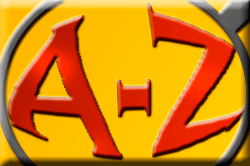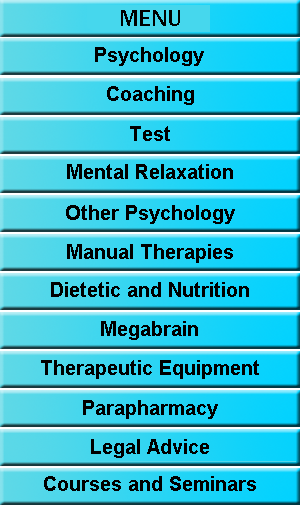

From these pages, our center provides you with a description of the symptoms of the most common diseases and disorders of the mind. Know that this relationship is purely informational and should under no circumstances be used for diagnostic, as this mission is optional, only, duly qualified professionals.
To make it easier to use, this relationship is sorted alphabetically. If you know the name of the disorder or disease that interests you, click on the letter that its name starts, in the following menu to go to the page that contains it.
| A (to Anorexia) |
Or if you prefer, directly looking for the name, you're interested in the alphabetical list of all the disorders or diseases that we see in this glossary, we offer you below:
AFFECTIVE PERSONALITY DISORDER
|
INITIAL |
|
Name |
|
Characteristics and Symptoms |
|
The acting thought is a thought disorder in which the sufferer tends to "hook" on the issue. It typically occurs in epileptic patients. |
|
Habitual Treatment |
|
Treatment is neurological and / or psychiatric. |
|
Name |
|
Characteristics and Symptoms |
|
This disorder is more common in children and involves hyperactivity, (the child moves and acts too quickly and inaccurately), and attention deficit (the affected costs focus attention and concentrate, due to intense physical activity developing). |
|
Habitual Treatment |
|
The treatment may be psychiatric and / or psychological. |
|
Name |
|
Characteristics and Symptoms |
|
It is a disorder of emotion,
which who suffers can not hide his joy or sadness
externally. |
|
Habitual Treatment |
|
The treatment is psychiatric and pharmacologic. |
|
Name |
|
Characteristics and Symptoms |
|
It is a disorder of emotion,
where the affected is unable to emotionally react to things.
|
|
Habitual Treatment |
|
The treatment is psychiatric and pharmacologic. |
|
Name |
|
Characteristics and Symptoms |
|
It is included into personality disorders and is characterized by anxiety disorders, anxiety, etc. |
|
Habitual Treatment |
|
The treatment may be psychiatric and / or psychological. |
|
Name |
|
Characteristics and Symptoms |
|
Aggressive behavior, can be divided into two groups: The hetero-aggressive, in these heads aggressiveness outside; involve destruction, humiliation and oppression from acts or words expressed directly (insults, humiliation, yelling, etc.) or subtle (irony, jokes, indifference, etc.) can reach its most extreme form in the violence, which is a physical manifestation of open aggression and self-injurious in which aggression is directed against the subject itself and goes from mutilation to suicidal behavior, they deserve separate treatment |
|
Habitual Treatment |
|
The treatment is, in general, psychiatric and pharmacological, often with the support of psychological therapy |
|
Name |
|
Characteristics and Symptoms |
|
It is a disorder of emotion,
where the sufferer shows great variability in the
affections. Any stimulus can pass from laughter to tears or
vice versa. |
|
Habitual Treatment |
|
The treatment is psychiatric. |
|
Name |
|
Characteristics and Symptoms |
|
Is the presence of
incongruous to the situation that has caused feelings. For
example sadness, in a situation of joy. |
|
Habitual Treatment |
|
The treatment is psychiatric and pharmacologic. |
|
Name |
|
Characteristics and Symptoms |
|
It consists of a psychic and
motor hyperactivation, a rapid succession of movements,
gestures and impulse to wander or run, although they can be
more or less intentional, often lack a common stable target
occurs. |
|
Habitual Treatment |
|
The treatment is psychiatric and pharmacologic. |
|
Name |
|
Characteristics and Symptoms |
|
It is a failure of
knowledge, due to injury or neural problems behind the
fissure of Rolando. |
|
Habitual Treatment |
|
Treatment is neurological. |
|
Name |
|
Characteristics and Symptoms |
|
It is a failure of
knowledge, due to injury or neural problems behind the
fissure of Rolando. |
|
Habitual Treatment |
|
Treatment is neurological. |
|
Name |
|
Characteristics and Symptoms |
|
It is a failure of
knowledge, due to injury or neural problems behind the
fissure of Rolando. |
|
Habitual Treatment |
|
Treatment is neurological. |
|
Name |
|
Characteristics and Symptoms |
|
It is a failure of
knowledge, due to shock or disorders. |
|
Habitual Treatment |
|
Treatment is neurological. |
|
Name |
|
Characteristics and Symptoms |
|
It is a failure of
knowledge, due to injury or neural problems. |
|
Habitual Treatment |
|
Treatment is neurological. |
|
Name |
|
Characteristics and Symptoms |
|
It is a failure of
knowledge, due to injury or neural problems. |
|
Habitual Treatment |
|
Treatment is neurological. |
|
Name |
|
Characteristics and Symptoms |
|
It is a failure of knowledge, due to injury or neural problems. It is typical of lesions on the right side. |
|
Habitual Treatment |
|
Treatment is neurological. |
|
Name |
|
Characteristics and Symptoms |
|
This phobia is characterized
by fear of open spaces. It is the exaggerated feeling
helpless in environments that do not provide the protection
that feels fear in domestic spaces. |
|
Habitual Treatment |
|
The treatment is psychological, even that can sometimes require psychiatric treatment and use of anxiolytics. |
|
Name |
|
Characteristics and Symptoms |
|
Is difficulty writing due to
injury. |
|
Habitual Treatment |
|
Treatment is neurological. |
|
Name |
|
Characteristics and Symptoms |
|
Is difficulty writing due to
injury. |
|
Habitual Treatment |
|
Treatment is neurological. |
|
Name |
|
Characteristics and Symptoms |
|
Is difficulty writing due to
injury. |
|
Habitual Treatment |
|
Treatment is neurological. |
|
Name |
|
Characteristics and Symptoms |
|
This disorder occurs when
drinking bad habits, has reached a level, which results,
psychological, somatic problems, and conflicts between
personal and professional relationships. |
|
Habitual Treatment |
|
In most cases, it is required to perform detoxification via hospitalization. Then, depending on the degree of neuronal damage and drinking habit, may require, neuropsychiatric treatment and pharmacologic supported by psychological therapy. |
|
Name |
|
Characteristics and Symptoms |
|
It is a disorder of sexual
behavior, where the perception of pain and humiliation is
sought actively (sadism) or passive (masochism). It is usual
that both alterations of the relationship, occur in the same
person and there is a higher frequency in males. |
|
Habitual Treatment |
|
It is rare for sufferers, come for help, but if they do the treatment may be psychiatric and / or psychological, depending on associated diseases, if any. |
|
Name |
|
Characteristics and Symptoms |
|
It is a neurological
disorder, which is the loss of the ability to write. |
|
Habitual Treatment |
|
Treatment is neurological. |
|
Name |
|
Characteristics and Symptoms |
|
It is a neurological
disorder, which is the loss of the ability to write. |
|
Habitual Treatment |
|
Treatment is neurological. |
|
Name |
|
Characteristics and Symptoms |
|
It is a neurological
disorder, which is the loss of the ability to write. |
|
Habitual Treatment |
|
Treatment is neurological. |
|
Name |
|
Characteristics and Symptoms |
|
It is a neurological disorder, which is the loss of the ability to write. It is related to defects in the catchment area. |
|
Habitual Treatment |
|
Treatment is neurological. |
|
Name |
|
Characteristics and Symptoms |
|
It is a disorder in which
sufferers lose the conceptual capacity developed to be aware
of their health status. |
|
Habitual Treatment |
|
Depending on the associated disorders will determine whether psychological therapy is required, or psychiatric and pharmacological. |
|
Name |
|
Characteristics and Symptoms |
|
Allotypic delusional ideas are those in which the patient has delusions of infidelity. It is typical of drinkers and paranoid. It is very dangerous |
|
Habitual Treatment |
|
The treatment, is psychiatric and pharmacological. |
|
Name |
|
Characteristics and Symptoms |
|
SEE FREEZING MIMICRY |
|
Habitual Treatment |
|
|
|
Name |
|
Characteristics and Symptoms |
|
Amnesia is memory lapses,
loss of memory completely or partially or inability to set
new materials in memory.
Amnesia are related to various
diseases such as dissociation hysteria, epilepsy, poisoning
and organic brain problems. |
|
Habitual Treatment |
|
The treatment, in many cases with hospitalization is medical, psychiatric or neuronal, depending on the disease to be treated |
|
Name |
|
Characteristics and Symptoms |
|
It is the inability to feel
pleasure. Nothing appeals to the person. Causes no interest.
No situation is funny or appealing. There is a feeling of
absolute boredom. No stimulus appears. |
|
Habitual Treatment |
|
The treatment, is
psychiatric and pharmacological. |
|
Name |
|
Characteristics and Symptoms |
|
Large decrease in vocabulary
when speaking. Inability to find the word that want to say.
|
|
Habitual Treatment |
|
Treatment is neurological. |
|
Name |
|
Characteristics and Symptoms |
|
The onset of the disease
usually occur between 12 and 30 years, although the trend in
recent years has been increasing age, so cases are in people
40 to 50 years. |
|
Habitual Treatment |
|
Psychological therapy and
hospitalization in cases where there is a weight loss you
need it-at the discretion of the physician. |
|
Name |
|
Characteristics and Symptoms |
|
The onset of the disease
usually occur between 12 and 30 years, although the trend in
recent years has been increasing age, so cases are in people
40 to 50 years. |
|
Habitual Treatment |
|
Psychological therapy and
hospitalization in cases where there is a weight loss you
need it-at the discretion of the physician. |
|
Name |
|
Characteristics and Symptoms |
|
Anorexia is when as a result of another illness arises such as endocrinopathies. |
|
Habitual Treatment |
|
When the primary disease refers anorexia disappears |
|
Name |
|
Characteristics and Symptoms |
|
Is the inability on the part
of a woman to achieve orgasm or have extreme difficulty to
get it. |
|
Habitual Treatment |
|
Treatment is by psychological and / or sexological therapy, except in cases of organic problems, where medical treatment is required. |
|
Name |
|
Characteristics and Symptoms |
|
This condition, caused by
lack of awareness of a body part, generally paralyzed. (Ex.
The subject not know they have a paralyzed leg). |
|
Habitual Treatment |
|
Treatment will be neurological or psychological depending on the causes of the problem. Sometimes both are needed. |
|
Name |
|
Characteristics and Symptoms |
|
It is included into personality disorders and is characterized by difficulty in relating to others. |
|
Habitual Treatment |
|
The treatment, is psychiatric and / or psychological. |
|
Name |
|
Characteristics and Symptoms |
|
In the crisis of anxiety,
all anxiety symptoms appear abruptly and with rapid
progression. It causes feelings of madness or smothering
sensations or both at once. |
|
Habitual Treatment |
|
Psychological therapy
including within it, relaxation techniques and / or
hypnosis. |
|
Name |
|
Characteristics and Symptoms |
|
It is an emotional state in
which the subject feels tense, frightened and alarmed
unpleasantly and usually accompanied by somatic
repercussions. When there is a stimulus that occurs
objectively not have the size needed to trigger the box. The
feeling of undefined fear is disproportionate to the
situations as they sense danger. |
|
Habitual Treatment |
|
Psychological therapy
including within it, relaxation techniques and / or
hypnosis. |
|
Name |
|
Characteristics and Symptoms |
|
In anxiety disorders, there
is little in common with generalized anxiety. |
|
Habitual Treatment |
|
The treatment is pharmacological. Certain antidepressants often used. |

Consulting of Psychology and Health Montse Valls Giner
Powered by Monvall.com